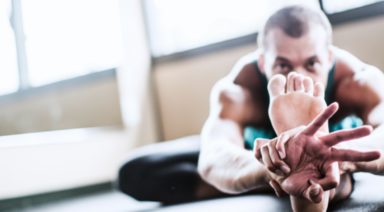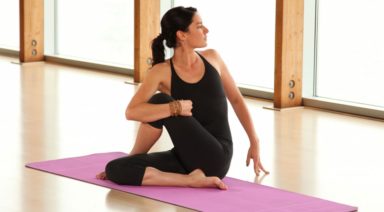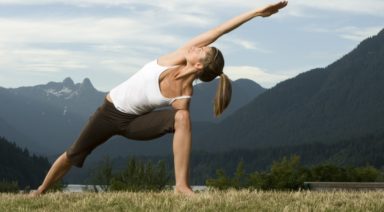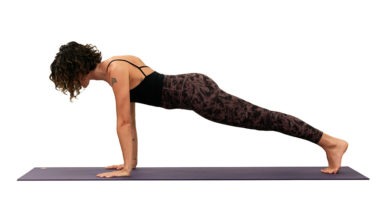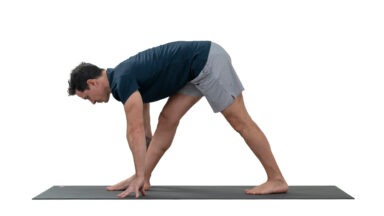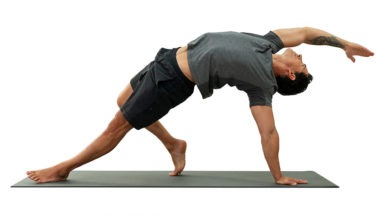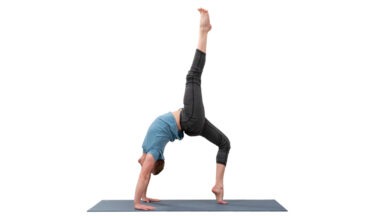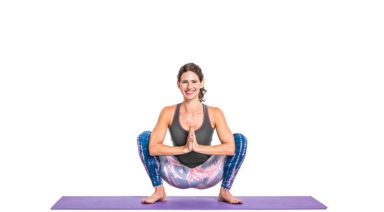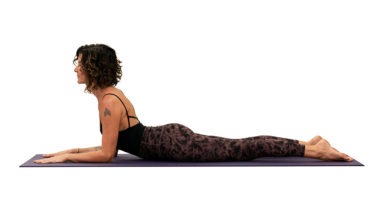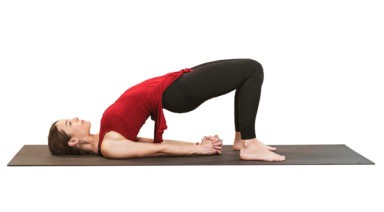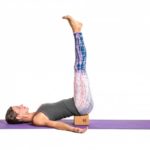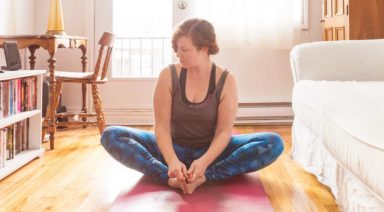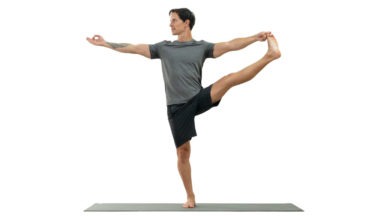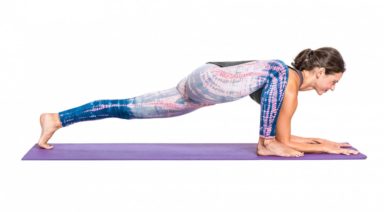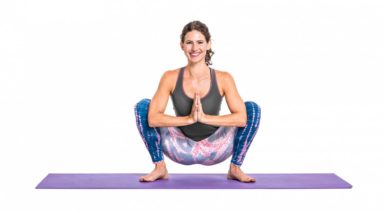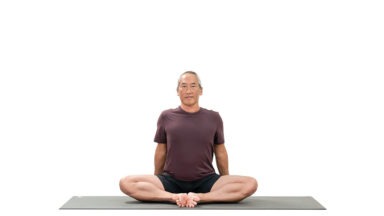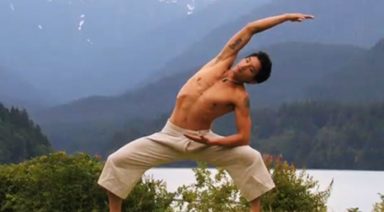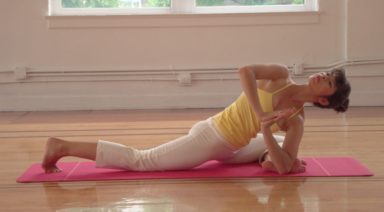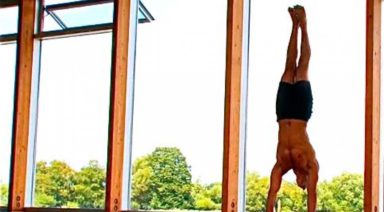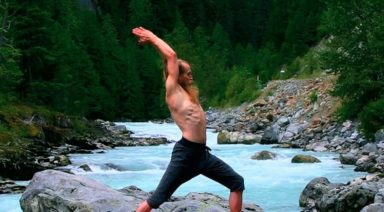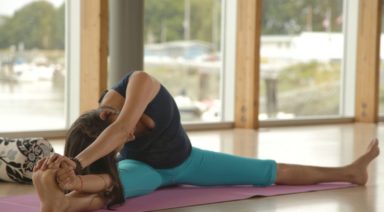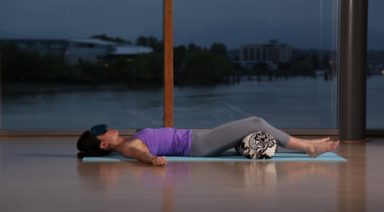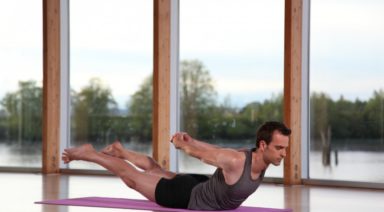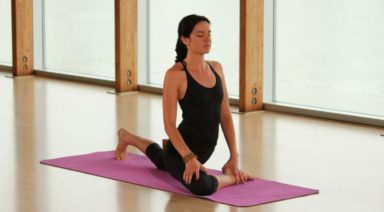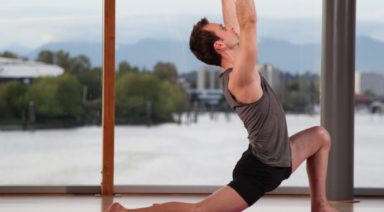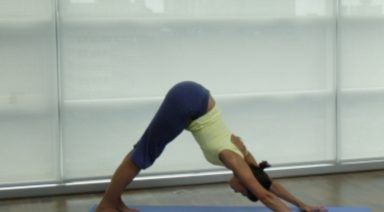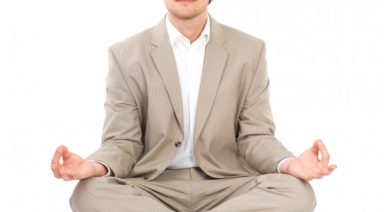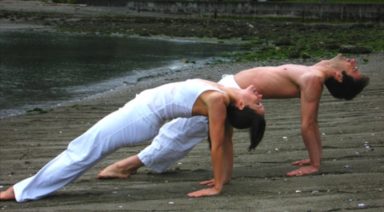Upset tummy? Try yoga for digestive relief

What else can yoga do for you? If you’ve overeaten or are facing digestive discomfort, fifteen minutes or so of yoga can make all the difference, according to Zayna Gold, creator of Healing Through Movement and a Boston-based yoga instructor. Here are just a few of the poses she recommends for settling your tummy, flattening out bloat, and easing stomach pains.
Don’t worry; these moves are very gentle and will work with the lightest of touches on calming your insides (both literal and metaphorical!). “You will feel less stress when your nervous system is relaxed. The health benefits will spread to the rest of your body and ease your digestion,” says Gold. Plus, the less you train your body to rely on over-the-counter meds like Pepto Bismol and Tums, the better! The natural, effective way is always preferable for long-term benefits.
- Apanasana
Benefits:
Practicing Apanasana, knees-to-chest pose, is a gentle way to restore proper flow and function to the organs of your torso. As you release excess pressure from your digestive organs and low back, your mind will begin to release its pressures and tensions, as well. It’s a simple way to encourage your body, mind, and spirit to remain pure and balanced throughout your day, as well as gives relief from excess digestive air, indigestion, bloating, flatulence, acidity, and constipation. Suffering from irritable bowel syndrome? This is the pose for you.
Plus, this pose helps to keep your low back limber. It is often used as a soothing counter-pose to backbends and spinal twists. Because your body is compact in the pose, your thoughts are more easily drawn inward, which is useful for calming the mind and rebalancing your energy.
However, make sure not to practice this pose if you are recovering from abdominal surgery or a hernia. Also avoid this pose if you have a spinal, knee, or hip injury. If you have a neck injury, do not lift your head.
Try It Out:
-
Begin by lying on your back, with your legs and arms extended.
-
As you exhale, draw both of your knees to your chest. Clasp your hands around them. If it is possible for you, wrap your forearms over your shins and clasp each elbow with the opposite hand.
-
Keep your back flat on the mat. Release your shoulder blades down toward your waist. Broaden across your collar bones.
-
Draw your tailbone and sacrum down toward the mat, lengthening your spine even more.
-
If it is comfortable for you to do so, softly rock backward and forward or side-to-side for a gentle spinal massage.
-
Tuck your chin slightly and gaze down the center line of your body.
-
Hold for up to one minute. Keep your breath smooth and even.
-
With an exhalation, release and extend both legs along the floor and rest. Repeat up to six times.
-
Bridge Pose
Benefits:
Bridge Pose is a chest, heart, and shoulders opener and works to stretch the spine, the back of the neck, the thighs, and the hip flexors (front hip joints). Because your heart is higher than your head in this pose, it is considered a mild inversion (less strenuous than other inversions, such as Headstand) and holds all the benefits of inversions, like relief from stress, fatigue, anxiety, headaches, insomnia, and mild depression. Get ready to have your mind be calmed and your blood pressure treated, and if you have asthma, it’s great for increasing lung capacity by opening the chest.
Why is Bridge Pose so great for digestion? It also stimulates the abdominal organs and thyroid glands, which improves digestion and helps to regulate metabolism. Because it revitalizes the legs and stretches the shoulders, it can be a particularly rejuvenating pose for those who spend the day sitting in front of a computer or driving.
Practicing Bridge Pose can be a potent lesson in learning to slow down and listen to your body. Your spine, shoulders, and thighs will tell you how far to take the pose. The less you push, the more the pose will open up. Turn your awareness inward and notice how your body releases its grip when you don’t force it. Let your Bridge be a connection between your body, mind, and spirit.
Try It Out:
-
Lie supine on the floor, and if necessary, place a thickly folded blanket under your shoulders to protect your neck. Bend your knees and set your feet on the floor, heels as close to the sitting bones as possible.
-
Exhale and, pressing your inner feet and arms actively into the floor, push your tailbone upward toward the pubis, firming (but not hardening) the buttocks, and lift the buttocks off the floor. Keep your thighs and inner feet parallel. Clasp the hands below your pelvis and extend through the arms to help you stay on the tops of your shoulders.
-
Lift your buttocks until the thighs are about parallel to the floor. Keep your knees directly over the heels, but push them forward, away from the hips, and lengthen the tailbone toward the backs of the knees. Lift the pubis toward the navel.
-
Lift your chin slightly away from the sternum and, firming the shoulder blades against your back, press the top of the sternum toward the chin. Firm the outer arms, broaden the shoulder blades, and try to lift the space between them at the base of the neck (where it’s resting on the blanket) up into the torso.
-
Stay in the pose anywhere from 30 seconds to 1 minute. Release with an exhalation, rolling the spine slowly down onto the floor.
-
Seated Forward Bend
Benefits:
Seated forward bend, or paschimottanasana, stretches the spine, shoulders, pelvis, and hamstrings. It also stimulates and balances the liver, kidneys, adrenal glands, ovaries, and uterus. And while traditional yoga texts say Paschimottanasana can cure disease, modern-day yoga teachers agree to its many other benefits, which include relief from stress, improved digestion and appetite, relief from menstrual pain and symptoms of menopause, a calmer mind, reduced anxiety and fatigue, improved sleep and relief from insomnia. This pose is also believed to be therapeutic for high blood pressure, infertility, and sinusitis. It is reputed to be beneficial for overcoming obesity, as well.
Though Paschimottanasana can feel “intense,” it can be easy to push your body too much, seeking more intense sensations as signs of progress. Be careful not to misinterpret painful, sharp, or piercing sensations as positive signs! Back off if you are injuring yourself.
The more you relax in the pose, the more naturally your body will open up. Forcing forward folds will actually cause your muscles to shorten and resist even more. Breathe deeply and evenly. Settle into the moment. Turn your thoughts inward and allow resistance to gently fade away.
Try It Out:
-
Sit on the floor with your buttocks supported on a folded blanket and your legs straight in front of you. Press actively through your heels. Rock slightly onto your left buttock, and pull your right sitting bone away from the heel with your right hand. Repeat on the other side. Turn the top thighs in slightly and press them down into the floor. Press through your palms or finger tips on the floor beside your hips and lift the top of the sternum toward the ceiling as the top thighs descend.
-
Draw the inner groins deep into the pelvis. Inhale, and keeping the front torso long, lean forward from the hip joints, not the waist. Lengthen the tailbone away from the back of your pelvis. If possible take the sides of the feet with your hands, thumbs on the soles, elbows fully extended; if this isn’t possible, loop a strap around the foot soles, and hold the strap firmly. Be sure your elbows are straight, not bent.
-
When you are ready to go further, don’t forcefully pull yourself into the forward bend, whether your hands are on the feet or holding the strap. Always lengthen the front torso into the pose, keeping your head raised. If you are holding the feet, bend the elbows out to the sides and lift them away from the floor; if holding the strap, lighten your grip and walk the hands forward, keeping the arms long. The lower belly should touch the thighs first, then the upper belly, then the ribs, and the head last.
-
With each inhalation, lift and lengthen the front torso just slightly; with each exhalation release a little more fully into the forward bend. In this way the torso oscillates and lengthens almost imperceptibly with the breath. Eventually you may be able to stretch the arms out beyond the feet on the floor.
-
Stay in the pose anywhere from 1 to 3 minutes. To come up, first lift the torso away from the thighs and straighten the elbows again if they are bent. Then inhale and lift the torso up by pulling the tailbone down and into the pelvis.
-
Balasana/Child’s Pose
Benefits:
The perfect way to wrap up your yoga therapy, Child’s Pose helps to stretch the hips, thighs, and ankles while reducing stress and fatigue. It gently relaxes the muscles on the front of the body while softly and passively stretching the muscles of the back torso.
This resting pose centers, calms, and soothes the brain, making it a therapeutic posture for relieving stress. When performed with the head and torso supported, it can also help relieve back and neck pain. Sometimes used as a counter-pose to backbends, Child’s Pose restores balance and equanimity to the body.
Life is the period between one breath and the next; the person who only half breathes, only half lives. He who breathes correctly acquires control of the whole being.
Regular practice of Child’s Pose also teaches conscious exploration of the breath. As the front of the body releases onto the thighs, the frontal ribs and abdominal muscles become slightly compressed. This restriction allows for a deeper opening of the back of the torso as the lungs expand behind the body. As this happens, keeping the breath slow, long, and steady allows for a new awareness of the breath’s path through the front and back of the body.
Try It Out:
-
Kneel on the floor. Touch your big toes together and sit on your heels, then separate your knees about as wide as your hips.
-
Exhale and lay your torso down between your thighs. Broaden your sacrum across the back of your pelvis and narrow your hip points toward the navel, so that they nestle down onto the inner thighs. Lengthen your tailbone away from the back of the pelvis while you lift the base of your skull away from the back of your neck.
-
Lay your hands on the floor alongside your torso, palms up, and release the fronts of your shoulders toward the floor. Feel how the weight of the front shoulders pulls the shoulder blades wide across your back.
-
Balasana is a resting pose. Stay anywhere from 30 seconds to a few minutes. Beginners can also use Balasana to get a taste of a deep forward bend, where the torso rests on the thighs. Stay in the pose from 1 to 3 minutes. To come up, first lengthen the front torso, and then with an inhalation lift from the tailbone as it presses down and into the pelvis.
Addiction Recovery Through Yoga
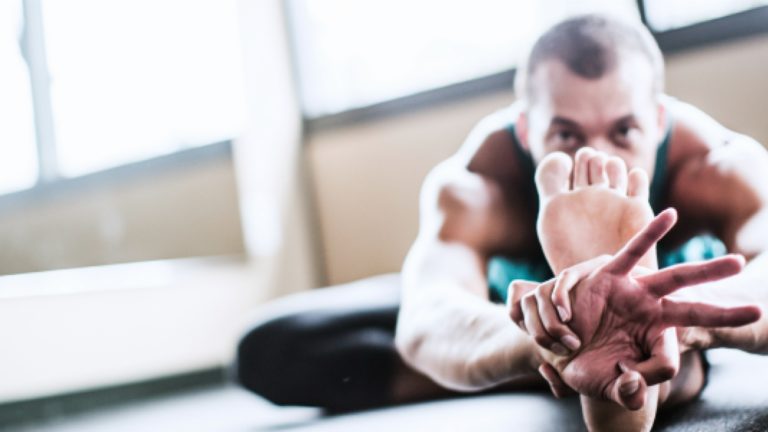
With all the images online of toned women in tights pulling themselves into pretzel-like poses, it’s easy to focus on the physical side of yoga, thinking of it as an exercise class that ends with a mini nap. But the ancient practice of yoga can also help with drug and alcohol addiction, diseases that affect millions of us in this fast-paced, modern world.
While yoga can be a powerful tool for personal transformation and recovery, many people write it off before even stepping onto a mat, saying they’re not flexible enough or they can’t afford the classes. Yet the mind-body connection, stress relief and personal growth that can occur through the regular practice of yoga can be just what a recovering addict needs. Yoga encourages a person to reconnect to their breath, body, mind and heart. Here are just a few ways yoga can help release the mind and body from the grips of drug and alcohol addiction.
Yoga Eases Stress
“It was such a crazy/stressful/hectic day… I need a drink” is such a common phrase in our culture, it’s easy to forget that there are healthy ways to cope with stress. Many addicts have become so dependent on their substance of choice, they’ve forgotten that movement or even just a few deep breaths can bring a real sense of calm to the day. And that moment of calm can lead to healthier choices as you move toward a sober life.
The benefits of mindful movement and breathing, which are at the center of many yoga classes, have been proven to increase overall health.
According to the American Institute of Stress, 20 to 30 minutes of deep breathing has been shown to help the body kick into a relaxation response, where stress levels drop and blood pressure decreases. “Deep breathing increases the supply of oxygen to your brain and stimulates the parasympathetic nervous system, which promotes a state of calmness,” according to an article on the organization’s website. “Breathing techniques help you feel connected to your body—it brings your awareness away from the worries in your head and quiets your mind.”
Nearly all yoga classes encourage students to consciously inhale and exhale, which brings peace to the mind and body, even as we move through a practice. If you commit even further, and regularly practice at home or at a studio, you might find yourself using deep breathing or a short yoga sequence to help you stay strong through a moment of temptation or stress.
This is especially important for addicts, as many suffer from post-acute withdrawal symptoms, or PAWS, in the early stages of recovery. These symptoms often include anxiety and mood swings. One study has shown that yoga directly helps to increase GABA, a neurotransmitter that aids in relaxing the nervous system, therefore improving your mood and decreasing anxiety.
Yoga Increases Self-Awareness
Addicts are often accused by their loved ones of being selfish. But devoting regular time to the kind of reflection that comes with yoga can be beneficial to those in recovery. More meditative types of the practice, like Yin Yoga, where there is little movement and just a few poses done in a single class, can create a meaningful space for really checking in with ourselves. While the questions that come to mind might not always be pleasant, these classes are set up as safe spaces for students to release emotions, and teachers are aware that their students might be struggling with all kinds of personal issues while in their studio. This type of contemplative yoga can help with anxiety, depression and even sleep issues. By dealing with some of the other factors that might be causing stress and unhappiness in your life, you might have more resolve or energy to commit to a recovery plan or time in a rehabilitation center.
Addressing the Roots of Addiction
Yoga is not superior in dealing with one addiction over another. Yoga begins to address the roots of a problem rather than the symptoms, making it a common tool among recovery from many addictions. If someone struggling with alcohol or drug addiction gets sober only to find him- or herself struggling with another addiction, such as food or gambling, yoga practices can be implemented to support in recovery from both addictions.
Yoga for General Wellbeing
Yoga can also be used as a tool to support general wellbeing regardless of addiction. For example, long deep breathing, or “yogic breathing,” has been shown to reduce levels of the stress hormone cortisol and increase stress resilience. Yoga can also be used to assist in dealing with trauma. According to Dr. Bessel van der Kolk, an expert in the field of trauma treatment, yoga may be more effective than many medications in treating PTSD. “Medication can be quite nice to sort of dampen some of the symptoms,” he states. “But in the end, people need to own their bodies, they need to own their physical experiences. And, in order to overcome your trauma, it needs to be safe to go inside and to experience yourself.”
Yoga asks you to show up for yourself. Although deep breathing can help relieve stress at any moment during the day, a physical yoga practice requires regularly carving out time for yourself. Even if you are just going to spend a few minutes stretching in your living room, you still must make the time to practice. As with any other type of physical exercise, you’ll see more benefits if you practice regularly. Yoga, for example, has been proven to ease chronic back pain and joint pain. Some studies have found that it can also help with mental health issues.
German researchers, for example, studied a small group of women who described themselves as “emotionally distressed.” Over a three-month period, they took two 90-minute yoga classes a week. At the end of the study, their stress, anxiety and overall health all improved. Similar studies have also shown the one-off benefits of even attending a single yoga class. The uniting factor in all of these cases? The participants showed up for themselves and attended a class. They might have had stressful days or felt anxiety about trying yoga or were plagued by depression, but they put all of that aside and spent the hour (or more) bending, breathing and stretching.
It’s easy to put off a yoga practice: to buy a mat or a DVD and let it go dusty. Or to attend a single class, but never step foot in the studio again. But the more you commit to yourself, and a regular mind-body practice, the more overall benefits you’ll begin to see and feel. A single healthy decision, like deciding to roll out your yoga mat, can change your focus for the day and encourage another healthy decision. Over time, those mindful moments will add up, perhaps leading to an overall more positive outlook and healthier lifestyle.
The Art of Surrender
Yoga requires us to surrender. The first of the 12 steps in Alcoholics Anonymous is “We admitted we were powerless over alcohol, that our lives had become unmanageable.” In a similar vein, yoga asks again and again that we drop everything that is not necessary in our lives. Most teachers will begin the class with a mind-clearing exercise and a short moment to set an intention. This helps us focus on the moment, and release all the other stresses in life. Similarly, some poses require surrender, as well.
Maybe there’s a complicated pose in class that you simply cannot twist your body into. That doesn’t mean you have to flop down on your mat or write the pose off for good. It simply means that accepting that today, that pose is not happening.
The same idea is true during some of the more “relaxing” poses. While your body might be still in a seated position, you may feel your mind racing. Again, yoga teaches us to simply surrender and to be present with who we are, where we are, right now. By engaging in a regular practice, we learn that acceptance comes with not being able to control the world around us but by allowing the world around us to exist as it is. By doing so we learn the art and gift of peaceful surrender.
In terms of learning to let go of expectations and limitations, yoga can be a boon for those who are recovering from addiction. In AA, the moment of surrender becomes “the firm bedrock upon which a happy and purposeful life is built.” The same is true in yoga: When we accept that a pose is out of our reach or that our minds cannot be quieted, we might finally find a moment of true freedom.



